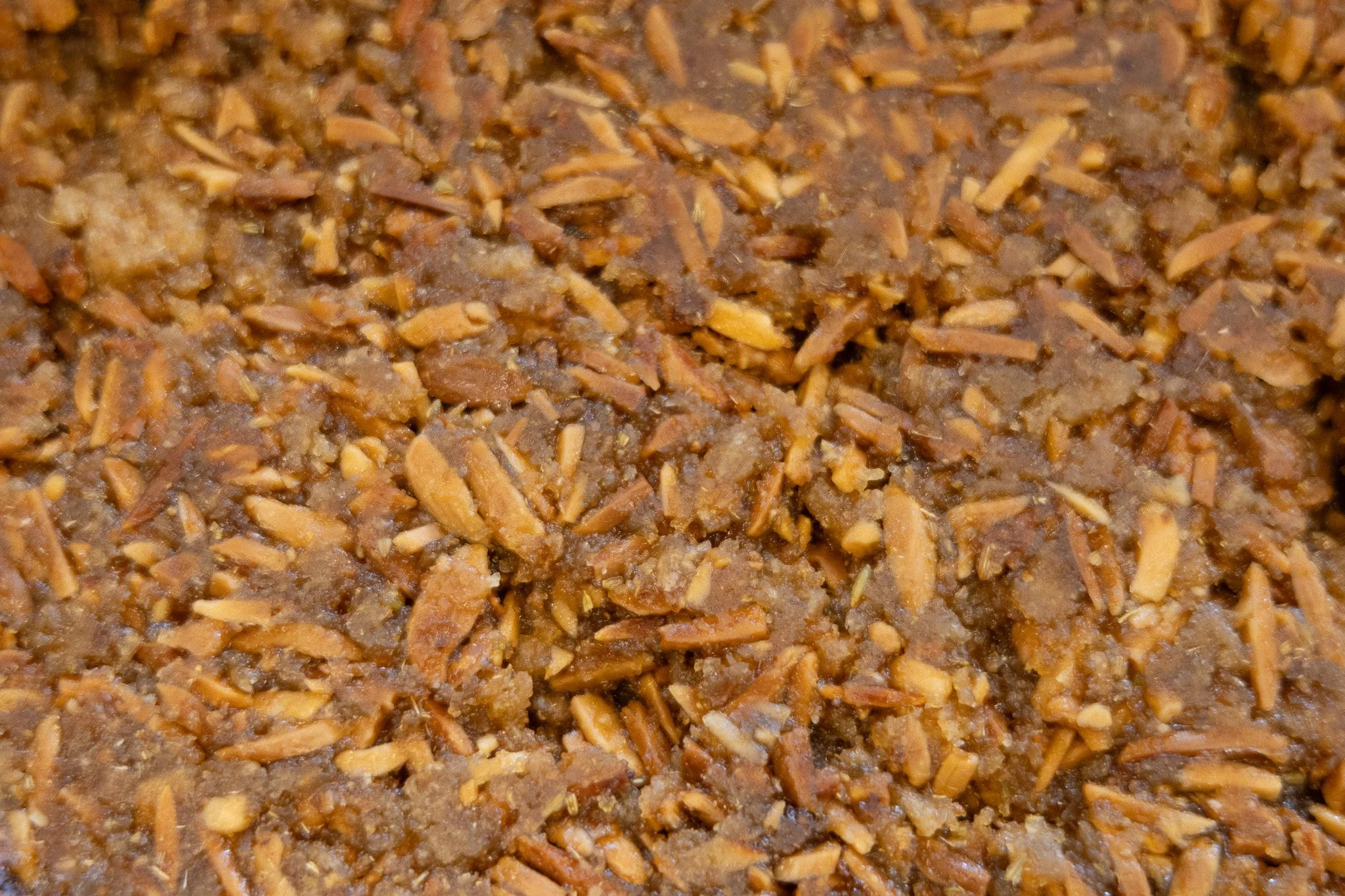Alajú
This is part of our series on upcycling bread by-products.
Table of Contents
i. Introduction
Alajú and alfajores are two related sweet Spanish confectioneries with shared Moorish heritage.¹ The former is typically associated with the city of Cuenca in Castilla-La Mancha, whilst Alfajor de Medina Sidonia, a variety of alfajor with similar ingredients and preparation², hails from Andalusia and holds protected geographical indication (PGI) status.³ Today, they are often eaten around Christmas, though they are also enjoyed at other feasts and special celebrations like Easter.
We certainly didn’t invent alajú or alfajores. Still, given how versatile and delicious they are, we respectfully think they should be more widely appreciated as a simple way to make something indulgent by using up stale bread. We offer our interpretation here.
ii. Recipe
Ingredients
100g dried breadcrumbs (or 150g fresh breadcrumbs)
50g water (or leave out if using fresh breadcrumbs)
250g honey
155g almond slivers
5g ground fennel seeds
20g lemon juice
Method
Bring the honey to a gentle simmer in a large pot.
Add the breadcrumbs and nuts, then cook at a relatively high temperature for 5 minutes. Stir the mixture frequently; it should be hot enough that it’ll burn if you don’t stir it frequently. As the honey caramelises, the mixture should darken a little.
Add the ground fennel seeds and lemon juice. Do this at the end of the cooking process, so they stay nice and bright.
Pour the mixture into a greaseproof paper-lined tray, cover the top with another sheet of greaseproof paper, place another tray on top, and then press down with a weight (like a pot of water) for a few hours.
After pressing, the mixture should set, something between fudge and a cereal bar in consistency. Slice the set mixture into individual servings. Optionally, cover the top and bottom with edible rice paper before slicing so the pieces can be eaten without getting sticky fingers.
iii. Adaptations
You don’t need to follow this recipe too strictly; the only non-negotiables are using breadcrumbs and something sugary to preserve them in.
We usually make this recipe with old sourdough bread. Any bread would work well, though stronger-flavoured breads like rye bread would affect the flavour profile. You could also experiment with the texture of the breadcrumbs, which could be ground up fine or kept in rougher pieces for different textures in the end product. It may even be possible to use old pastries instead of bread, though you should use ‘plainer’ pastries rather than those filled with e.g. cream, which probably wouldn’t work so well. We haven’t tried making alajú with pastries, but if you do, you’d need to adjust the recipe to account for differences in sugar and fat.
Many sources of sweetness could work just as well as honey: try agave, maple syrup or any kind of liquid or melted sugar. Different sources of acid could also work; for example, you could use citric acid, lemon flesh or apple cider vinegar. You could use no acid at all, although we think some is nice to cut through the sweetness of the honey. You could also try different nuts, dried fruits, and/or flavouring that pairs with the rest of your selected ingredients. Why not pay homage to the recipe’s medieval Moorish roots and try spices like sumac, cloves, nutmeg, sumac, ras el hanout, or other spices and blends like chilli or Chinese five spice? Equally, it could be nice with no spices at all.
Contributions & acknowledgements
Kim performed the original culinary R&D. Eliot reproduced Kim’s recipe and documented the process with additional notes, which he used to help write the article following further discussions with Kim. Josh contributed editorial feedback. Eliot photographed the alajú in our food lab.
Related posts
Endnotes
[1] Sometimes erroneously referred to as a ‘lost dessert resurrected from medieval texts’, alajú and alfajores have been passed down from generations in the regions where it is enjoyed. See: G Blázquez Abellán, M Orzáez Villanueva and A Díaz Marquina (1999), ‘Bromatology study in "alajú" and "alfajores"’, Ars Pharmaceutica.
[2] Many different kinds of dessert referred to as ‘alfajores’ are eaten across Spain and Latin America, though not all share as much in common with alajú as Alfajor de Medina Sidonia; one notable example is a dulce de leche cookie that is popular in Argentina. See: Luceta di Cosimo (2017), ‘Alfajores or alaju - traditional Spanish sweets’, BMDL, Aethelmarc.
[3] Alfajor de Medina Sidonia PGI, Qualitavia Foundation.






